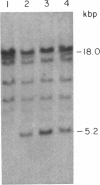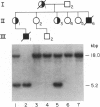Abstract
Two additional restriction fragment length polymorphisms (RFLPs) have been identified at the human ornithine transcarbamylase (OTC) locus. Approximately 11% of women are heterozygous for an RFLP characterized by polymorphic bands at 3.7 and 3.6 kilobasepairs (kbp) observed after DNA digestion with TaqI. Twenty-nine percent of women are heterozygous for an RFLP characterized by polymorphic bands at 18.0 and 5.2 kbp observed after digestion with BamHI. Thus, in combination with the previously reported RFLPs identified using MspI, the X chromosomes in approximately 80% of women at risk for having a son with OTC deficiency are distinguishable by RFLPs at the OTC locus. Furthermore, we show that these RFLPs will be useful in families for prenatal diagnosis of OTC deficiency, carrier detection, and carrier exclusion.
Full text
PDF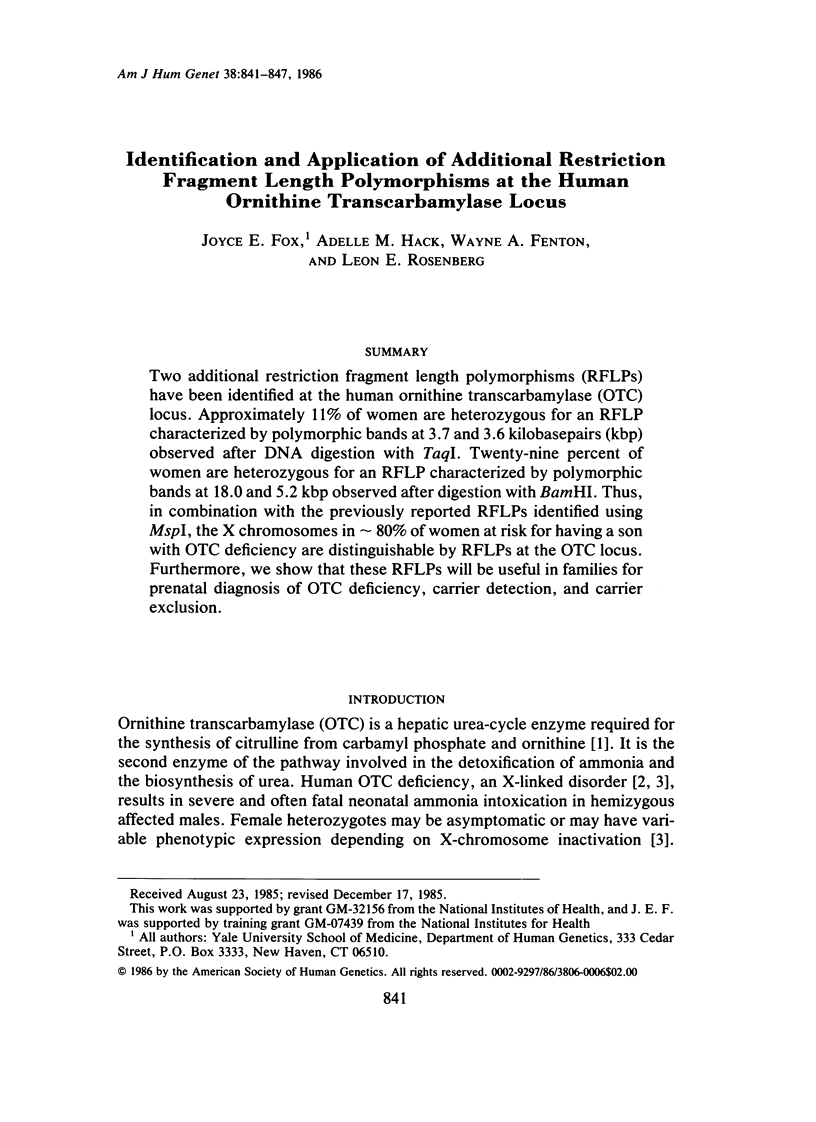
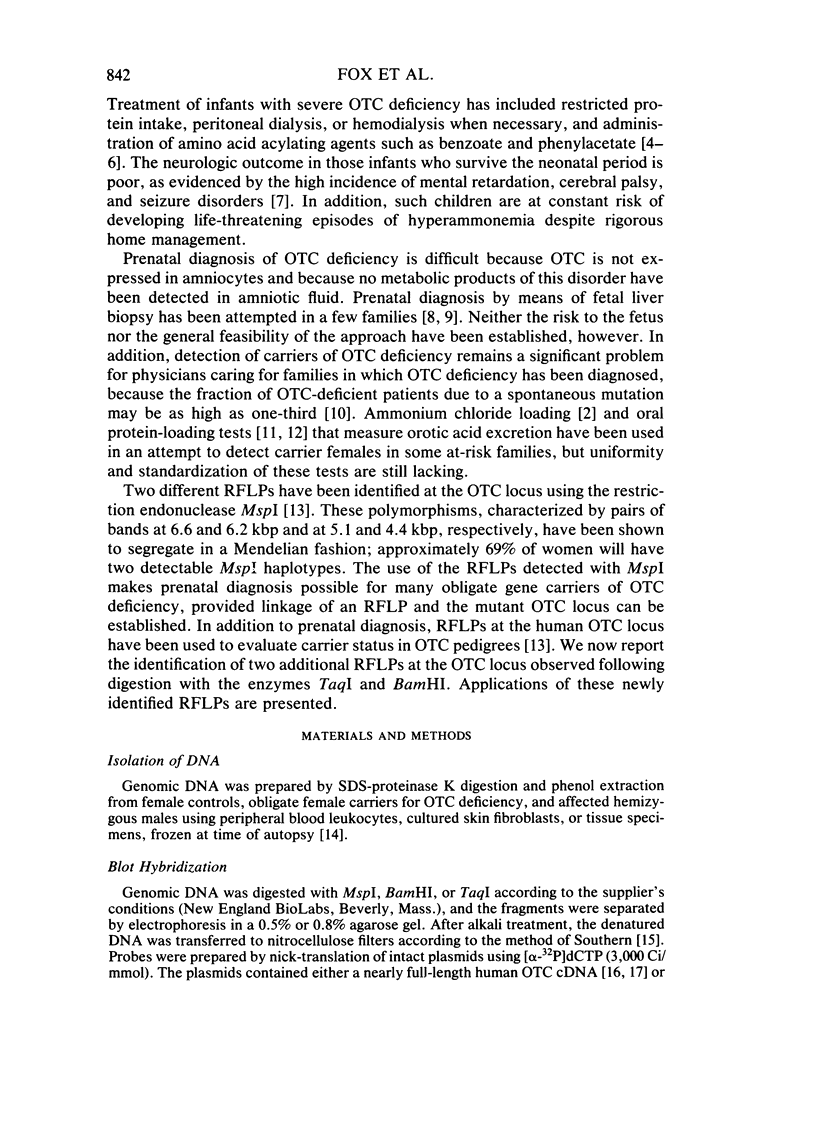
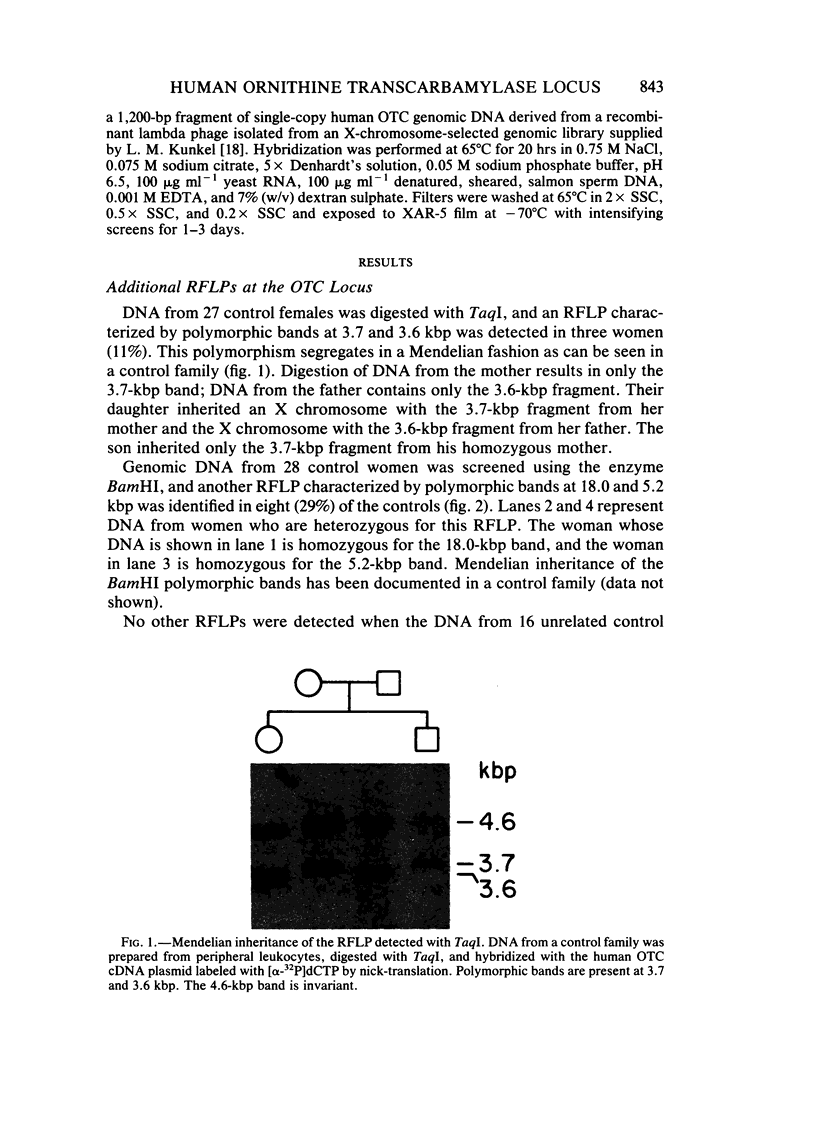
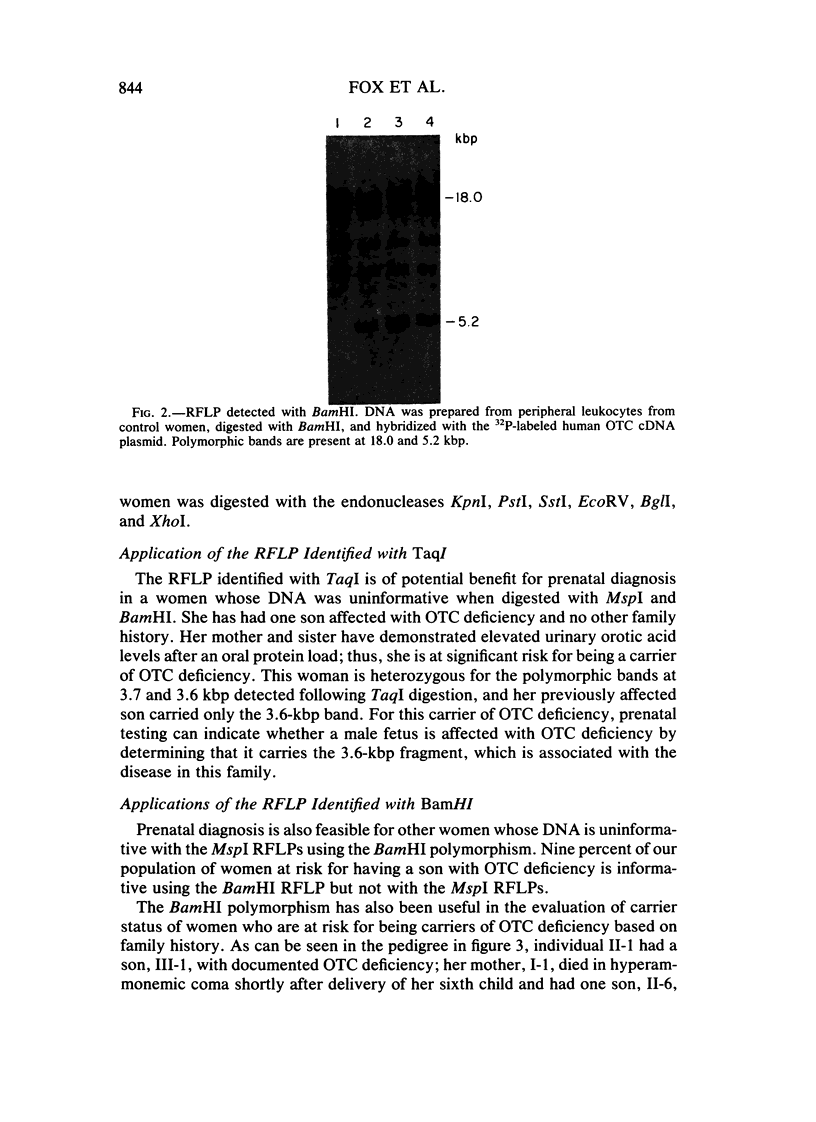
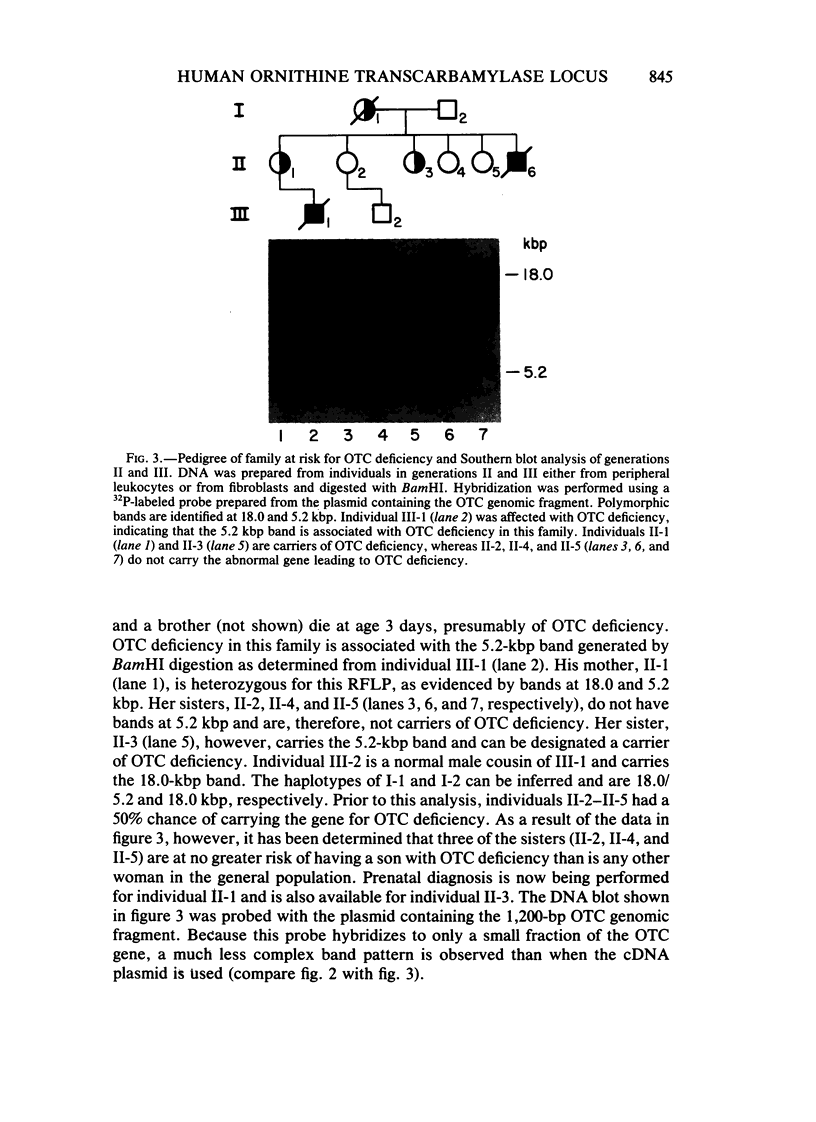
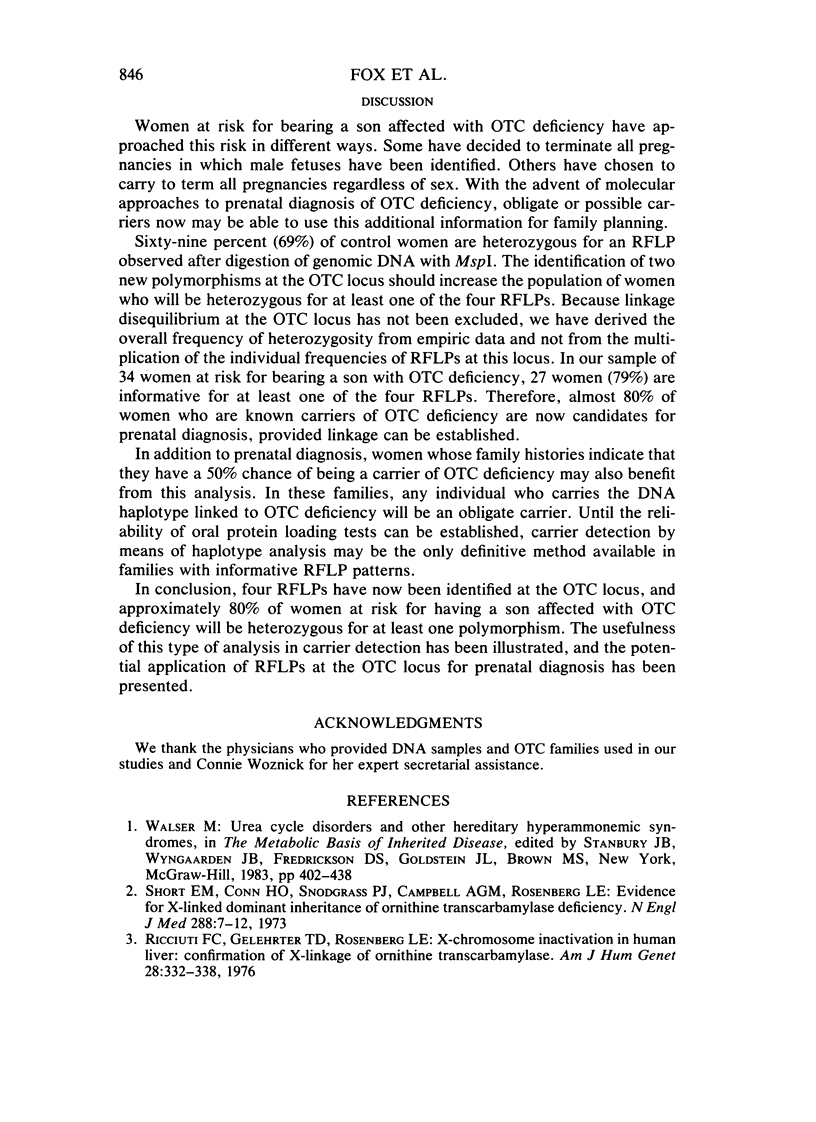
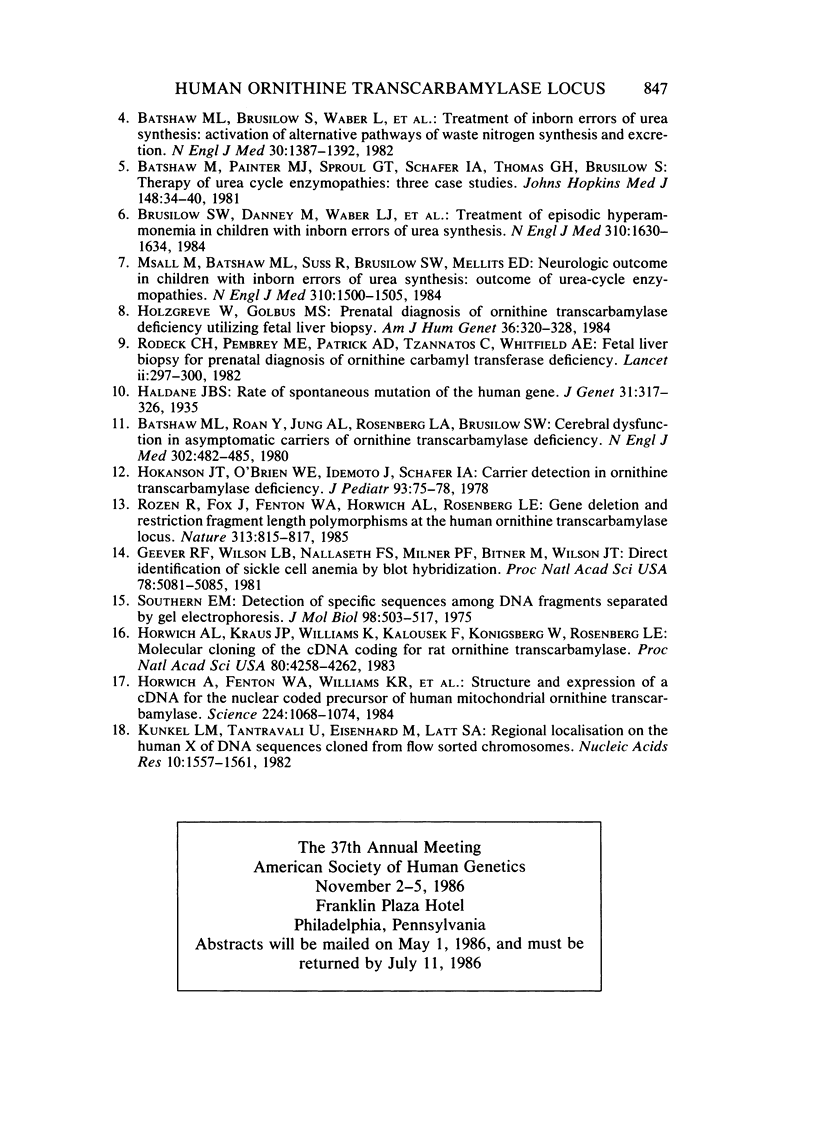
Images in this article
Selected References
These references are in PubMed. This may not be the complete list of references from this article.
- Batshaw M. L., Brusilow S., Waber L., Blom W., Brubakk A. M., Burton B. K., Cann H. M., Kerr D., Mamunes P., Matalon R. Treatment of inborn errors of urea synthesis: activation of alternative pathways of waste nitrogen synthesis and excretion. N Engl J Med. 1982 Jun 10;306(23):1387–1392. doi: 10.1056/NEJM198206103062303. [DOI] [PubMed] [Google Scholar]
- Batshaw M. L., Painter M. J., Sproul G. T., Schafer I. A., Thomas G. H., Brusilow S. Therapy of urea cycle enzymopathies: three case studies. Johns Hopkins Med J. 1981 Jan;148(1):34–40. [PubMed] [Google Scholar]
- Batshaw M. L., Roan Y., Jung A. L., Rosenberg L. A., Brusilow S. W. Cerebral dysfunction in asymptomatic carriers of ornithine transcarbamylase deficiency. N Engl J Med. 1980 Feb 28;302(9):482–485. doi: 10.1056/NEJM198002283020902. [DOI] [PubMed] [Google Scholar]
- Brusilow S. W., Danney M., Waber L. J., Batshaw M., Burton B., Levitsky L., Roth K., McKeethren C., Ward J. Treatment of episodic hyperammonemia in children with inborn errors of urea synthesis. N Engl J Med. 1984 Jun 21;310(25):1630–1634. doi: 10.1056/NEJM198406213102503. [DOI] [PubMed] [Google Scholar]
- Geever R. F., Wilson L. B., Nallaseth F. S., Milner P. F., Bittner M., Wilson J. T. Direct identification of sickle cell anemia by blot hybridization. Proc Natl Acad Sci U S A. 1981 Aug;78(8):5081–5085. doi: 10.1073/pnas.78.8.5081. [DOI] [PMC free article] [PubMed] [Google Scholar]
- Hokanson J. T., O'Brien W. E., Idemoto J., Schafer I. A. Carrier detection in ornithine transcarbamylase deficiency. J Pediatr. 1978 Jul;93(1):75–78. doi: 10.1016/s0022-3476(78)80606-4. [DOI] [PubMed] [Google Scholar]
- Holzgreve W., Golbus M. S. Prenatal diagnosis of ornithine transcarbamylase deficiency utilizing fetal liver biopsy. Am J Hum Genet. 1984 Mar;36(2):320–328. [PMC free article] [PubMed] [Google Scholar]
- Horwich A. L., Fenton W. A., Williams K. R., Kalousek F., Kraus J. P., Doolittle R. F., Konigsberg W., Rosenberg L. E. Structure and expression of a complementary DNA for the nuclear coded precursor of human mitochondrial ornithine transcarbamylase. Science. 1984 Jun 8;224(4653):1068–1074. doi: 10.1126/science.6372096. [DOI] [PubMed] [Google Scholar]
- Horwich A. L., Kraus J. P., Williams K., Kalousek F., Konigsberg W., Rosenberg L. E. Molecular cloning of the cDNA coding for rat ornithine transcarbamoylase. Proc Natl Acad Sci U S A. 1983 Jul;80(14):4258–4262. doi: 10.1073/pnas.80.14.4258. [DOI] [PMC free article] [PubMed] [Google Scholar]
- Kunkel L. M., Tantravahi U., Eisenhard M., Latt S. A. Regional localization on the human X of DNA segments cloned from flow sorted chromosomes. Nucleic Acids Res. 1982 Mar 11;10(5):1557–1578. doi: 10.1093/nar/10.5.1557. [DOI] [PMC free article] [PubMed] [Google Scholar]
- Msall M., Batshaw M. L., Suss R., Brusilow S. W., Mellits E. D. Neurologic outcome in children with inborn errors of urea synthesis. Outcome of urea-cycle enzymopathies. N Engl J Med. 1984 Jun 7;310(23):1500–1505. doi: 10.1056/NEJM198406073102304. [DOI] [PubMed] [Google Scholar]
- Ricciuti F. C., Gelehrter T. D., Rosenberg L. E. X-chromosome inactivation in human liver: confirmation of X-linkage of ornithine transcarbamylase. Am J Hum Genet. 1976 Jul;28(4):332–338. [PMC free article] [PubMed] [Google Scholar]
- Rodeck C. H., Patrick A. D., Pembrey M. E., Tzannatos C., Whitfield A. E. Fetal liver biopsy for prenatal diagnosis of ornithine carbamyl transferase deficiency. Lancet. 1982 Aug 7;2(8293):297–300. doi: 10.1016/s0140-6736(82)90272-0. [DOI] [PubMed] [Google Scholar]
- Rozen R., Fox J., Fenton W. A., Horwich A. L., Rosenberg L. E. Gene deletion and restriction fragment length polymorphisms at the human ornithine transcarbamylase locus. 1985 Feb 28-Mar 6Nature. 313(6005):815–817. doi: 10.1038/313815a0. [DOI] [PubMed] [Google Scholar]
- Short E. M., Conn H. O., Snodgrass P. J., Campbell A. G., Rosenberg L. E. Evidence for x-linked dominant inheritance of ornithine transcarbamylase deficiency. N Engl J Med. 1973 Jan 4;288(1):7–12. doi: 10.1056/NEJM197301042880102. [DOI] [PubMed] [Google Scholar]
- Southern E. M. Detection of specific sequences among DNA fragments separated by gel electrophoresis. J Mol Biol. 1975 Nov 5;98(3):503–517. doi: 10.1016/s0022-2836(75)80083-0. [DOI] [PubMed] [Google Scholar]




